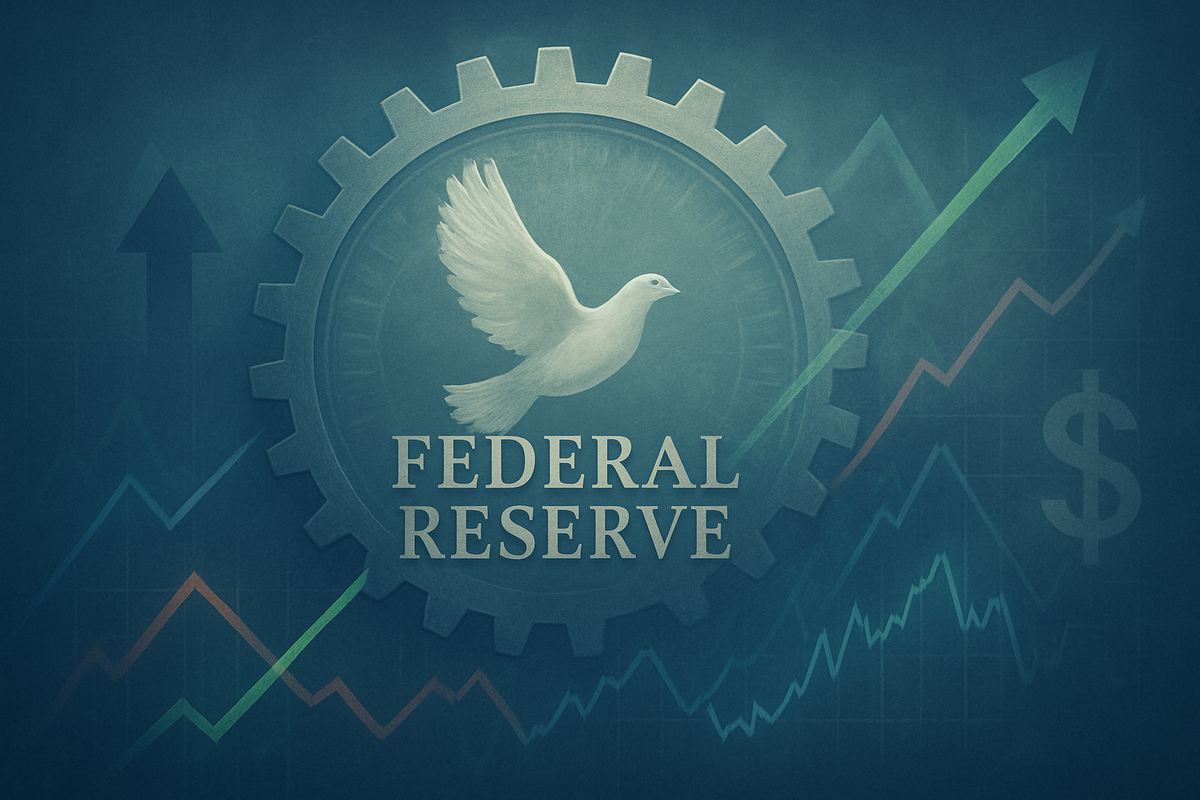
New York, NY – November 17, 2025 – Federal Reserve Governor Christopher Waller continues to be a prominent voice advocating for further interest rate cuts, even as the broader market and some of his colleagues express caution. On the current date, November 17, 2025, Waller reiterated his call for an additional rate cut in December, citing a weakening labor market and inflation trending towards the central bank's 2% target. This persistent dovish stance from a key Fed official injects a layer of complexity into financial markets, which are already navigating a landscape of mixed economic signals and a Federal Open Market Committee (FOMC) seemingly divided on the pace and necessity of further monetary easing.
The immediate market reaction to Waller's latest remarks has been relatively subdued, described as "marginal" for the EUR/USD pair. This muted response, however, belies the underlying tension. By late Friday, November 14, short-term interest rate futures surprisingly indicated a 60% chance that the Fed would avoid another rate cut in December, a stark reversal from earlier expectations. This shift suggests that while Waller's voice is influential, the collective sentiment, possibly swayed by more hawkish comments from other Fed speakers and Chair Powell's recent caution, is leading investors to re-evaluate the probability of imminent cuts.
Waller's Consistent Call for Easing Amidst Fed Deliberations
Governor Waller's advocacy for lower interest rates has been a consistent theme throughout 2025, positioning him as one of the more dovish members of the FOMC. His latest push for a December rate cut on November 17 follows a series of similar pronouncements. Just weeks prior, on October 31, 2025, in a Fox Business Network interview, he publicly supported a December cut, which contributed to "ripples through financial markets," prompting a re-evaluation of rate expectations. This built upon his October 16 speech at the Council on Foreign Relations, where he explicitly backed a 25 basis point reduction at the October 29 FOMC meeting, highlighting a "conflict" between solid economic growth and a softening labor market.
The FOMC did indeed cut its benchmark interest rate by 25 basis points to a target range of 3.75%-4.00% on October 29, a move widely anticipated. However, the subsequent press conference by Fed Chair Jerome Powell introduced significant uncertainty. Powell stated that a December interest rate cut was "not a foregone conclusion" and "far from it." This cautious tone immediately pushed U.S. Treasury yields higher, with the 2-Year Treasury yield climbing 10 basis points to 3.59% and the 10-Year Treasury yield moving up 8 basis points to 4.05%, as investors sold off government bonds. Equities turned negative, and the US Dollar Index (DXY) extended its recovery, illustrating the market's sensitivity to signals beyond just one Governor's opinion. Earlier in the year, Waller had also advocated for cuts in September (September 3 CNBC interview and August 28 speech) and July (July 17 speech), even dissenting against holding rates steady at the July FOMC meeting. His July remarks, alongside strong retail sales data, did contribute to a rally in the S&P 500 (NYSE: SPX), a dip in 10-year Treasury yields, and a softer U.S. dollar, showcasing the market's initial receptiveness to his dovish signals.
Market Winners and Losers in a Rate-Sensitive Environment
The ongoing debate surrounding interest rate cuts, heavily influenced by figures like Governor Waller, creates a clear dichotomy of potential winners and losers in the financial markets. Companies and sectors that thrive in a lower interest rate environment are likely to benefit from Waller's dovish stance, while those that rely on higher rates or are sensitive to economic uncertainty may face headwinds.
Potential Winners:
- Technology and Growth Stocks: Companies like Microsoft (NASDAQ: MSFT) and Apple (NASDAQ: AAPL), with their future-oriented earnings, tend to perform well when interest rates are lower, as the present value of their future cash flows increases. Waller's push for cuts makes these growth narratives more attractive.
- Real Estate: Homebuilders such as PulteGroup (NYSE: PHM) and D.R. Horton (NYSE: DHI), along with real estate investment trusts (REITs), typically benefit from lower mortgage rates, which stimulate housing demand and reduce borrowing costs for development.
- High-Leverage Companies: Businesses with significant debt loads could see their financing costs decrease, improving profitability and reducing default risks.
- Emerging Markets: A weaker U.S. dollar, often a consequence of lower U.S. rates, can make emerging market assets more attractive to international investors.
Potential Losers:
- Traditional Banks: While lower rates can stabilize the economy and reduce credit risks, an aggressive series of cuts can compress net interest margins (NIM), the difference between what banks earn on loans and pay on deposits. Major banks like JPMorgan Chase (NYSE: JPM) and Bank of America (NYSE: BAC) might see their profitability squeezed if NIMs shrink too rapidly. However, if rate cuts prevent a severe recession, this could mitigate credit losses.
- Value Stocks: In a low-rate environment, the allure of stable, dividend-paying value stocks might diminish as growth stocks offer higher potential returns.
- U.S. Dollar: Waller's dovishness, if it translates into actual Fed policy, could weaken the U.S. dollar, making imports cheaper but potentially impacting the competitiveness of U.S. exports and reducing the attractiveness of dollar-denominated assets for foreign investors.
Wider Significance: The Fed's Balancing Act and Broader Trends
Governor Waller's consistent advocacy for rate cuts underscores the inherent tension within the Federal Reserve's dual mandate: achieving maximum employment and maintaining price stability. His focus on a weakening labor market and confidence in inflation trending downwards suggests a prioritization of supporting economic growth, even as some of his colleagues express concerns about persistent inflationary pressures or the need to maintain a restrictive stance for longer. This internal debate is crucial, as the Fed's collective decisions have profound ripple effects across the global financial landscape.
The market's mixed reaction to Waller's statements—sometimes embracing the dovishness, other times pulling back due to broader Fed caution—highlights the data-dependent nature of monetary policy and the challenge of interpreting forward guidance. Historically, periods of internal Fed disagreement have often led to increased market volatility as investors struggle to price in future policy moves. For instance, the adverse market reaction to Waller's more cautious comments in January 2024, when he pushed back against overly aggressive rate cut expectations, serves as a precedent for how market sentiment can quickly shift when Fed communication deviates from prevailing narratives. The current situation also fits into broader industry trends of navigating a post-pandemic economic environment characterized by supply chain disruptions, geopolitical tensions, and evolving labor market dynamics, all of which complicate the Fed's task. Regulatory bodies will be closely watching how the Fed balances these competing objectives, as its decisions influence everything from corporate borrowing costs to consumer spending power.
What Comes Next: Navigating Uncertainty and Strategic Pivots
Looking ahead, the immediate focus for investors and analysts will be the December 2025 FOMC meeting. While Governor Waller's dovish voice is clear, the collective decision will hinge on incoming economic data, particularly inflation reports and labor market statistics, as well as the consensus among the wider committee, especially Chair Powell's guidance. Short-term possibilities include either a continued pause in rate cuts, a modest 25-basis-point reduction, or, less likely, a more aggressive move if economic data deteriorates sharply.
In the long term, the trajectory of monetary policy into 2026 will be shaped by the Fed's ability to achieve a "soft landing"—cooling inflation without triggering a recession. Potential strategic pivots for companies might involve re-evaluating debt structures in anticipation of fluctuating interest rates or adjusting investment strategies based on sector-specific sensitivities to monetary policy. Market opportunities could emerge in sectors poised to benefit from lower rates, such as technology and housing, if cuts materialize. Conversely, challenges will persist for businesses highly sensitive to economic downturns or those reliant on sustained high-interest margins. Investors should prepare for continued volatility and be ready to adapt to various scenarios, ranging from a prolonged "higher-for-longer" rate environment to a more aggressive easing cycle if economic conditions warrant.
Comprehensive Wrap-Up: A Market on Edge
In summary, Fed Governor Christopher Waller's consistent and vocal advocacy for interest rate cuts throughout 2025 has been a significant, albeit sometimes counter-current, influence on market expectations. His focus on a softening labor market and decelerating inflation positions him as a key proponent for monetary easing. However, the broader market's reaction, influenced by more cautious signals from other Fed officials and Chair Powell, suggests a nuanced interpretation of the Fed's likely path. While Waller's dovishness provides a tailwind for interest-rate-sensitive sectors like technology and real estate, the overall uncertainty surrounding the pace and timing of future cuts creates challenges for traditional banking and can lead to broader market volatility.
Moving forward, the market remains data-dependent and highly sensitive to every utterance from Fed officials. Investors should closely monitor upcoming economic indicators, particularly inflation and employment reports, as well as the minutes and statements from future FOMC meetings. The ongoing internal debate within the Federal Reserve underscores the delicate balancing act required to manage the economy. The significance of this period lies in the Fed's attempt to navigate a path between sustaining economic growth and ensuring price stability, a journey that will undoubtedly continue to shape market sentiment and investment strategies in the months to come.
This content is intended for informational purposes only and is not financial advice







